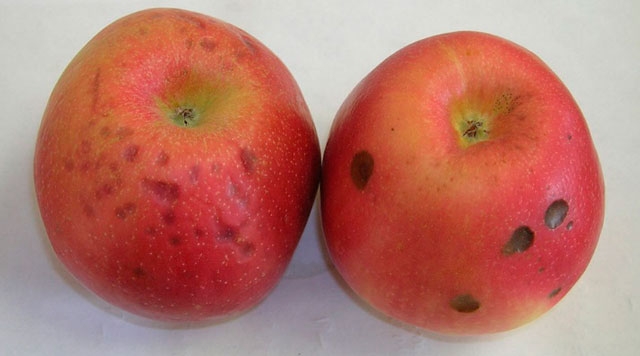To maximise a tree crops genetic potential, hormones must remain balanced throughout the plant’s natural hormone cycle.
Crop nutrition inputs supply the plant with essential elements resulting in a balanced and therefore a natural, healthy growing tree crop.
One essential element during flowering and reproduction is calcium, the building block for cell walls in new tissue.
A tree which is deficient in calcium will have cell walls that are weaker and more susceptible to fungal attacks. A tree with adequate levels of calcium in its tissue can protect the fruit from pathogens and breakdown.
Most fruit cell division happens early (just after flowering) when the fruit is small.
Calcium is important for orderly cell division and it is important that the young fruit receives adequate calcium in an available form.
Avoid pitter pit in apples
In the case of apples, the University of Maine identifies a Honey Crisp apple which is suffering from bitter pit symptoms due partially to a calcium deficiency (see Figure 1).
The disorder begins in the orchard, however, browning may not become visible until post-harvest.
Honey Crisp is just one apple variety prone to the disorder. Regular applications of calcium can prevent bitter pit in most cases.
Similarly, other tree fruit crops can manifest calcium deficiency in many ways, most of which result in the breakdown of the fruit either during growth or after harvest.
Calcium is also important for root and leaf growth and nutrient uptake.
Recommended calcium source
Stoller’s SETT/CaB is our recommended calcium source for fruit tree crops (and it includes boron).
Calcium cross–links cells and bonds cell walls in all plant tissue. Stronger cells mean better fruit.
Calcium tends to follow the transpiration stream of the plant (where the water moves in the tree). So soil applied calcium generally moves to, and favours, the leaves (where most moisture is lost) rather than the fruit.
A good source of calcium applied as a foliar will help to improve calcium levels in all the tree, not just the fruit.
Calcium as a secondary messenger
Calmodulin is a protein that contains calcium and is active in plants. This protein acts as a ‘second messenger’ in plants.
It controls enzymes and plant processes that determine how the tree grows. If there is insufficient calcium found in the tree, the signalling in the tree can become impaired.
Conclusion
So, you can see that the secondary nutrient calcium is of primary importance to tree performance and fruit quality, helping with orderly cell division, cell wall formation and signalling in the tree.
Products such as Stoller’s SETT/CaB, make it easy for the tree and fruit to absorb much needed calcium to the leaves, woody tissue and fruit.
This enhanced supply of calcium ensures better fruit and improved farm profitability.
Contact Stoller Australia phone 1800-Fertiliser
www.stoller.com.au
See this article in Tree Fruit Nov 2017






















